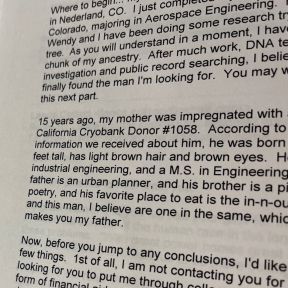The Birth Parent Experience
Birth parents, both mothers and fathers, are a key piece of the adoption puzzle. The vast majority make the difficult decision to place their child for adoption out of what they perceived to be the child’s best interests; many also go on to form close, loving relationships with their child and his or her adoptive family later on, through a process known as open adoption.
But birth parents are often left out of larger discussions of adoption, which tend to focus on the needs of adoptive parents and adoptees themselves. They may also be the victim of unfair stereotypes—some mistakenly believe, for instance, that all birth parents are teenagers or that they all struggle with substance abuse (neither of which are true). As a result, many birth parents may struggle with complex emotions about their decision to adopt and its aftermath but feel as if they have few places to turn. Seeking support from family, friends, legal professionals, and therapists both before and after adoption—and providing themselves space to navigate difficult feelings and grieve afterward if necessary—can help birth parents feel secure in their decision and prepare for an ongoing relationship with their child if they so choose.
Deciding to place a child for adoption is not a choice that should be made lightly, and often requires careful consideration of the expectant parent(s)’ personal circumstances, financial situation, morals and values, and plans for the future. Because the vast majority of modern domestic adoptions are open or at least semi-open—meaning that the birth parent(s) will continue to be in the child’s life in some capacity—prospective birth parents will also need to consider how much contact they would ideally like to have with the child after he or she is born and placed.
Expectant parents who are unsure of how the process works or who feel pressured by family members to decide one way or the other should seek help from an unbiased party if necessary. A therapist, an adoption attorney, or a reputable adoption agency may be able to provide counseling that helps them come to the decision that is right for them.
Some pregnant individuals or couples know immediately that adoption is the best choice, while others agonize over the decision. The latter group may have some desire to parent the child themselves, but worry that they’ll be unable to do so due to age, money, or other roadblocks; they may also consider abortion, but face financial, legal, or personal barriers to doing so. These are all valid concerns, and each should be considered carefully.
Ultimately, there is no one way to tell whether adoption will be right for any particular individual or couple. To help themselves make the choice, however, those considering it should ask themselves several questions:
1. Do they understand the process of adoption?
2. Do they feel forced or pressured into a decision, or do they feel able to decide of their own free will?
3. If they chose to place the child for adoption, do they have a sense of what their relationship with their child would ideally look like after he or she has gone home with the adoptive parents?
4. Have they spent a significant amount of time thinking this decision through?
Potential birth parents are advised to learn as much as possible about the adoption process before making their final choice; if necessary, they should seek the help of an adoption counselor or adoption legal expert for support. Reading birth parent accounts—both positive and negative—can help them understand the potential pros and cons of placing their baby with another family. Seeing a therapist, too, can help those considering adoption make sense of their own emotions around the process.
Individuals and couples who have made the often difficult decision to place their baby for adoption may be faced with the further challenge of having to defend their decision to an unsupportive family.
In some states, birth parents who are minors may need their parents’ permission to place a baby for adoption in certain instances. However, for the vast majority of prospective birth parents, the decision can be made without family input or approval. That doesn’t mean, however, that familial support is unwanted or unnecessary—indeed, many birth parents report that their family’s support (or lack thereof) was a major influence on their own emotions and mental well-being during the adoption process.
To encourage a family to offer their support, birth parents are advised to share their motivation for the decision in clear, personal terms. Perhaps placing a baby for adoption will allow the birth parent(s) to pursue education or career goals and increase their future stability. Perhaps the birth parent feels she is too young to parent successfully. Explaining such reasons to wavering family members can help them see the potential benefits of adoption for the birth parent’s life.
Family members may also have outdated, inaccurate views of adoption and worry that the process will be coercive or emotionally damaging to their loved one. Prospective birth parents should share as much information about the process as possible—making it clear that they will be able to choose the family, decide on levels of contact, and may be able to get financial assistance during the pregnancy. Sharing information about the adoptive parents, once they are chosen—and perhaps setting up a meeting if it feels appropriate—can further help reluctant family members make sense of the decision and recognize that adoption may be what’s best for the child.
Couples who disagree on whether to place their baby for adoption may face serious emotional strife as they try to come to an agreement. Though it will likely be immensely challenging, talking over the situation openly and honestly is the first step. Each partner should share their concerns about parenting the child and/or placing him for adoption, and make an effort to listen to the other partner without judgment. If emotions are running too high for an agreement to be reached, it may be necessary to get professional help from a therapist—either a couples’ therapist or one who specializes in adoption.
Though the pregnant partner may have a legal advantage in some cases, if both parents are known, they may each have the same parental rights (depending on the specific circumstances of the relationship and the location in which they live). Thus, it is important—especially in a long-term or ongoing relationship—that both partners be honest with each other about the pregnancy and their motivations for pursuing (or not desiring) an adoption and to make every effort to come to an agreement.
It can be. Birth parents—and particularly birth mothers—often become emotionally attached to the child during pregnancy. Even if they are confident that they want to pursue adoption, placing the child with his or her adoptive parents can result in intense feelings of grief, guilt, loneliness, or depression.
Birth parents should not hesitate to seek help for these challenges. Adoption—even if it is the right choice for a particular birth parent—always involves some degree of loss; birth parents who felt pressured into their decision may feel an additional layer of sadness or of regret. Regardless of the specific circumstances, there is no shame in feeling pain afterward, and birth parents deserve support as they attempt to navigate such feelings.
Yes. Even birth parents who are secure in their decision may struggle with feelings of guilt afterward—they may suddenly feel that they should’ve parented the child themselves, for instance, and were “weak” or “selfish” for not doing so; they may also fear that their child will be angry at them later on and feel guilty for causing them future pain.
Birth parents should seek help for these feelings if necessary. They should also remind themselves that feeling guilt does not necessarily mean that their choice was incorrect or selfish. Adoption is a difficult decision to make even in the best of circumstances; it is natural for difficult emotions to arise even after the process has been formally completed.
The period right after a child is placed for adoption can be particularly painful for birth parents as they attempt to come to terms with their decision and make sense of what their life will be like going forward. Family and friends, if they are supportive of the adoption, can be an excellent resource to help birth parents work through their difficult emotions—including guilt, depression, confusion, or shame. It can also be immensely helpful to seek out support groups of other birth parents; these can be found online, through adoption agencies, or via local community centers or religious establishments. If therapy is financially feasible, it can be helpful as well.
Today—at least in the U.S.—many birth parents remain in contact with their child and his or her adoptive family after the adoption is complete and as the child grows. While this arrangement is rewarding in many ways for all parties involved, it can be frustrating, too. Birth parents, in particular, may feel out of sync with their child’s adoptive family or unsure what their role is in the child's life. They may also face difficult emotions, particularly as boundaries shift, the relationship changes, or milestones are reached. Honesty and patience—both with their child’s adoptive family and with themselves—can help birth parents remain in their child’s life, if they so choose, without sacrificing their own emotional well-being.
Adoptions can be classified as open, semi-open, or closed. Though the large majority of domestic adoptions today are open or semi-open, it is still possible to pursue a traditional closed adoption if that’s what the birth parent(s) want. Birth parents should carefully consider the pros and cons of each form of adoption before making their final decision.
Open adoption—in which birth parents and adoptive families maintain consistent contact and even meet in person regularly throughout a child’s life—is often considered psychologically healthier for both birth parents and children. For birth parents, it allows the opportunity to see the child grow up, develop a meaningful relationship with them, and feel assured that they placed their child in a safe, happy home. For children, open adoption allows them to resolve unanswered questions about their adoption, make sense of their birth parents’ decision, feel connected to their culture, and learn about their family history if they so choose.
On the other hand, open adoption can present emotional challenges for birth parents. Adoptive families and birth families may struggle to establish clear boundaries or disagree on how much contact is needed; birth parents may feel as if their feelings are sidelined or as if their needs in the relationship are ignored. Birth parents may also feel sadness or guilt when seeing or parting from their child, which can complicate how they feel about their decision to place the child for adoption.
In semi-open adoptions, adoptive parents send occasional photo and text updates to the birth parents, usually at an agreed-upon schedule. Adoptions that are semi-open have the potential to become more open later if both parties consent.
Closed adoption was once the norm but has become increasingly rare. In a true closed adoption, birth parents would not learn any information about the adoptive family before or after placement, and vice versa. Some birth parents may feel that closed adoption provides them with a “clean break” and may decide that it is the best way to gain closure.
On the other hand, many birth parents in closed adoptions report feeling high levels of grief after the adoption due to their inability to learn any information about their child’s life. Children, too, may struggle with feelings of rejection, questions of identity, and a sense of abandonment that is less likely to be problematic in an open adoption.
Connecting with a reputable adoption agency, seeking counseling, and talking the decision over with loved ones can help birth parents come to a decision that is best for their emotional well-being.
Prior to placing their child for adoption, birth parents should think carefully about what they would want their ideal relationship with their child and his or her adoptive family to look like. Would they prefer in-person visits? Would they be happier with periodic phone calls or photographic updates? Then, working with an adoption counselor or agency, the birth parent can draft a contact agreement that feels appropriate for them and ask that the adoptive parents agree to it before moving forward.
Such agreements, while useful, are not perfect, and it’s common for expectations and boundaries to evolve over time. If a birth parent feels later on as if their desire for contact has changed, they should feel empowered to bring that up to the adoptive parents. Ideally, the adoptive parents will recognize the value of the birth parent’s role and make an effort to accommodate their needs; if they are uncooperative, however, an adoption counselor can help mediate between the parties.
In general, experts advise birth parents to start with the lowest level of contact they are comfortable with, and build from there. Since all relationships take time to develop naturally, moving too quickly or pushing for too much time together may result in birth parents feeling overwhelmed or out of place. Starting slow, and expanding contact as both parties become more comfortable with each other, is most likely to create a lasting relationship.
Open adoption isn’t always easy, despite its benefits. Many birth parents report ups and downs in their relationship with their child—it may be primarily joyful for months or years, only to shift and become fraught with grief and sadness. This is normal, and birth parents should seek help for these feelings as necessary (either from a therapist, a friend or family member, or some other supportive person).
Birth parents may find that the best source of comfort is other birth parents. Seeking advice on how they navigated similar situations, or how long such feelings of sadness or confusion typically last, can help birth parents feel supported and better understand the complexities and challenges of an open adoption relationship. In-person support groups or online forums are both useful in this regard.
If visits with the child or the adoptive family become too painful, birth parents may wish to let the adoptive parents know that they would like a break. As with other aspects of open adoption, honesty is the best policy; ideally, adoptive parents will recognize that this need for space is a form of self-care and will not necessarily be permanent. It’s also possible to dial back contact without ending it entirely. Replacing in-person visits with phone calls, for instance, or phone calls with emails, can help birth parents take the time they need to care for their mental health without shutting down the relationship altogether.
Because adoptees technically have at least two mothers and/or at least two fathers, holidays like Mother’s Day or Father’s Day can feel fraught for both birth and adoptive parents. Some birth parents prefer to be recognized on Mother’s Day or Father’s Day in some form, even if it’s just a phone call from their child. Others would rather the adoptive family not acknowledge the day or celebrate them on a different day (Birth Mother’s Day is a holiday, celebrated the Sunday before Mother’s Day, that was established by birth mothers in the 1990s for just such a purpose).
Regardless, birth parents and adoptive parents should aim to be honest with the other about what they want and how they would prefer the day be spent. It’s normal for either party to feel hurt if they are not able to spend the holiday with their child. In open adoptions, as children grow older, they may begin to make their own decisions about parent-related holidays; some may choose to spend some Mother’s Days or Father’s Days with their birth parents and others with their adoptive parents.
Yes, birth fathers can continue to have a relationship with their child after adoption if they choose. If the birth mother and father continue to be on good terms with one another, they can work together on the open adoption agreement and discuss levels of contact that are appropriate for both of them. If a birth father is not close to the birth mother, but still remains interested in pursuing an open adoption, he can reach out to the adoption agency for help facilitating contact with the adoptive family.
Many birth parents who placed their child for adoption—particularly if they originally entered into a closed adoption—are blindsided when the child suddenly makes contact, often decades later. How birth parents respond to this new relationship is deeply personal and meeting or speaking to the child for the first time can provoke complex feelings.
Some birth parents, especially those who felt pressured to place their child or who wanted an open adoption, are happy to be contacted and eager to begin a new relationship; others are more reluctant but open to the idea, while still others don’t want a relationship at all.
Ultimately, birth parents who are interested in some form of contact are often advised to take it slow; trying to form a close connection too quickly can lead one party to push the other away or to become overwhelmed. Starting with calls or emails before working up to in-person visits is a route chosen by many parents and children who go on to have successful relationships.
A birth parent may not want a relationship with their child, especially if they’ve spent years coming to terms with their decision and feel as if they have the closure they need. This is their right, and only individual birth parents can decide what is best for them. While rejecting their child’s attempt at a relationship will likely cause the child pain, honesty is, as always, the best policy for parents and children alike.
On the other hand, adopted children may pull back from the relationship at some point, even if they were the one who initiated contact. This can be triggering for birth parents, especially those who were eager to connect with their child. Seeking support for their renewed grief—from friends, family, or a therapist—is critical to help birth parents make sense of this newfound loss. Some ultimately report that seeing the child as an adult, even if the relationship ultimately faltered, helped them find closure and learn to be at peace with their decision.














